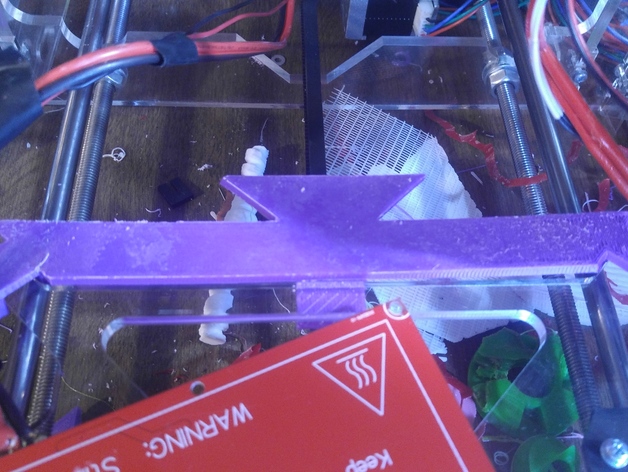
Heated Bed wire holder for Reprap heated bed
thingiverse
I have had three prints ruined because one of the wires to my heated bed broke because of metal fatigue where the copper wires are soldered to the PCB heater bed. On my printer, the wires just dangle. As the printer moves in the Y direction, the wires bend and bend and eventually break. I thought of this general designa few weeks ago but I had taped the wires into a bundle and had thought that would fix it. Yesterday one of the wires broke anyway and a pokeball peeled up on one side. So I printed this. This was my fourth attempt. Changes I made were: Properly fitting the hooks to the X frame. Making the main structure thinner to reduce the chance of warping, speed up printing, and reduce material used. The second to last attempt fit except that the part was not "tall" enough. Because of that, it put stress on the X frame. I realized installing it that it would possibly warp the hot plate and make the bed much harder to level. I added the box under the central tab. Now the fit is "relaxed". I printed the part in ABS since it will be used by the heated bed. I want it to be more resistant to heat. I used the "fantail" so that wire ties could be used without holes - but I decided to use a piece of electrical tape instead. But the fantail and various appendages make it vaguely look like a very abstract thunderbird. If I knew how to make this parametric, I would set: The distance of the straight line. that is, the long rectangular piece. The angle of the arms. The size of the diamond arms that are going to the corners of the bed so that the size of the hook could be set. The thickness of the piece (distance between top of hook and flat tab. optional: The size of the fantail. This object is sized for my reprap printer kit. I hope it will work for you. Print Settings Printer Brand: RepRap Printer: reprapguru kut Rafts: No Supports: Yes Resolution: 0.4mm nozzle, 0.2 layer Infill: 22% Notes: I used 3 layers on the sides (1.2mm) and I started with 6 layers on top and bottom (1.2 mm) but then I changed it to 5 (1.0) with better results. The filament took 3 layers to bridge and fill in with 15% infill but the change to 22% infill relieved a lot of the bridging problems and the third laer was almost solid, while the fourth and fifth were solid and smooth. I believe that the best way to print this is to print it with the hooks up and support "touching buildplate". The only thing that needs support in that orientation is the tab. With the default settings in cura, the support breaks away cleanly and easily. Printing it in that orientation with a very wide brim (I used 12 circles) on adhesive coated glass (mix of spray adhesive and hairspray) on a hot build plate (set to 124C) finally got the item to print with no warping. It took 1 hour, 27 minutes to print. I elected to print it diagonally - it probably would have barely fit oriented long way X or Y but the placement seemed easier this way. Again, I used ABS because it is said to be more resistant to hot environments. Post-Printing Installation Other than removing the brim and supports, no trimming was required. The heat plate had to be completely removed to install it. If the x frame is warped at all, you should not leave it installed = bending the X frame might cause insurmountable leveling issues. If you can't remix it on tinkercad, give me the Thickness (z direction of your X frame and/or the distance along the straight piece and I will try to build you one (when I read my comments). The support should be slightly loose on the X frame and then the wires can be attached to the support using your favorite method, I guess you could use heat shrink if you cut the fantail or had massive heat shrink, or you could use wire ties or tape, The point is to eliminate the repeated flexing that causes the wires to fail because of metal fatigue, so the wires need to be firmly attached to the fantail. How I Designed This I actually had two goals in designing this. To eliminate flexing at the solder joints. To allow for one of the wire management systems, like the chains, to have a place to mount, so that the wires would be protected from abrasion. I have not tackled that yet. In my mind the shape of the piece was a simple composite of geometric shapes - rectangles and triangles. Thus, tinkercad became the obvious solution. I designed it using the current beta. It is called "reprap heated bed power wire holder" and my id there is nicksimicich.
With this file you will be able to print Heated Bed wire holder for Reprap heated bed with your 3D printer. Click on the button and save the file on your computer to work, edit or customize your design. You can also find more 3D designs for printers on Heated Bed wire holder for Reprap heated bed.
